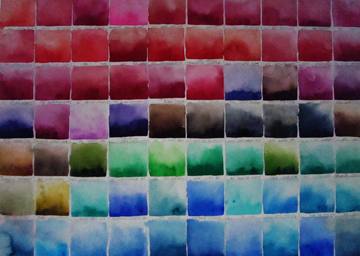"How do I paint
this reflection" is a question that comes up frequently. So while the
snow flies outside, I've made a cup of tea and have a chocolate chip
cookie that our family packed for us before we left Wilmington, NC
(where it was 70' yesterday), so let's see what happens!
 |
| Cloud Patterns on the Lake | | | | | |
|
|
|
|
|
|
A
reflection is literally a mirror image. The shapes being reflected are
in reverse. The reflected objects on water are always darker OR lighter
than the objects they are reflecting.
A
good rule of thumb is that lighter objects will reflect darker, and
darker objects will reflect lighter. However, be aware that the darkest
reflection cannot be as dark as the darkest reality. Direct observation
in nature will illustrate this. It is difficult to tell from a
photograph.
This is how I painted these reflected clouds:
- I completed the "reality" from the sky to the shoreline.
- then I lightly sketched in the cloud shapes. I don't want the pencil line to show so I keep it very light.
- I mixed up several colors that I expected to
use in the reflections. It's very important to have the same amount of
pigment and water in each mixture so that you can control the edges of
each shape as you paint them
-
beginning at the left hand side by the shore, I took my time and
painted each shape, wet paint on dry paper, moving from one shape, color
and value to another.
-
Because I am painting one shape next to another, the edges merge softly
and look like water. If I see that an edge is beginning to dry before I
can paint the adjacent shape, I soften that drying edge with a damp
brush so that I can come back to it and continue with a soft edge.
BE CAREFUL NOT TO HAVE EXTRA WATER ON YOUR BRUSH when you do this as it will run into the adjacent shape and create "blooms".
It isn't necessary to paint fast; BUT you must watch the edges of each shape and keep it damp so that you can paint up to it.
Water
also distorts the reflection if there is any movement. Ripples and
waves will distort the shape of the reflected object. Rippled water is
like looking at series of tilted mirrors.
I
think you can see in this painting that although the water is only
slightly disturbed, that the edges of the reflected clouds are "broken"
or irregular.
|
 |
| Detail of plein air watercolor |
In this example, you can see that the color of the sand under the water affects the colors that are seen in the reflection.
|
This is a painting of mud flats at low tide with the sky and clouds reflected on the wet mud.
These reflections were painted using the same technique as the cloud reflections.
Additionally, when the reflections were dry, I added a few sunlit
spots with white gouache. This helps add "sparkle" to the water - almost
like little bubbles.
You can also add these sparkles with masking fluid before
beginning. Paint the tiny shapes carefully, and also spatter tiny
sparkles with a toothbrush.
This is another example of how the
underlying colors of the wet mud affect the colors of the reflections.
Although these reflections are seen on the sea bed rather than on clear
water, I use the same method to paint them.
The main difference is that I also
added wet in wet marks on the damp pigment to create the look of
seaweed, stones, and the myriad textures of the wet seabed.

Evening Sky Reflected on the Bay
22 x 30"
Private Collection
If
you turn this painting upside down, it reads perfectly well with a low
horizon line and the painting becomes all about the sky rather than the
bay.
When painting wet shapes one after another in a large size it's necessary to plan how you are going to tackle it.
For this painting, I made sure that I mixed up all of the colors that I wanted to include in the watery reflection.
Then, using a large brush (always use the biggest one you can use for the shape you are painting),
I began at the horizon line, and painting wet pigment on dry paper, I
loaded my brush with a lot of pigment and water and painted each area
one after another until I reached the bottom of the painting.
Where
I wanted to increase the value of a shape, I "charged" more pigment
mixture into it before it began to dry. Once these shapes begin to dry,
it's best not to try to go back into them to make changes. Wait until
it's totally dry, and then re-paint, using a very light hand, and
keeping the edges softly merged.
I
hope this inspires you to try some reflections. I suggest that you try
four quarter sheets with different compositions, and practice. In a
nutshell:
- mix your colors with the same amount of pigment and water.
-
after you clean your brush, lay it on a sponge or towel to take out
the excess water so that you don't alter the proportions of pigment and
water in your mixtures.
- mix more pigment mixtures than you think you need.
- don't go back into damp washes; if you must make a change in that shape, wait until it's dry, re-wet and paint again.
Have fun and let me know how it goes!
|
































